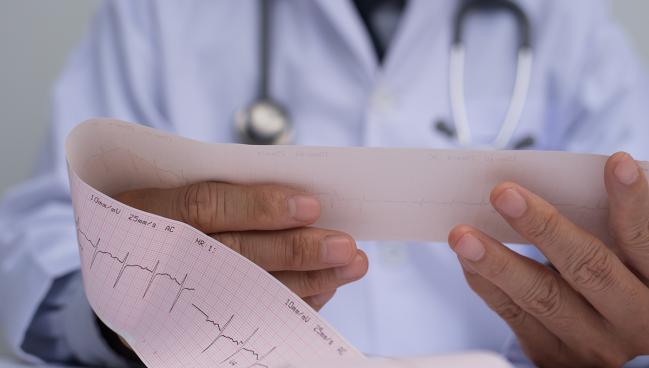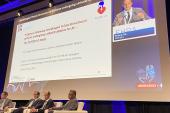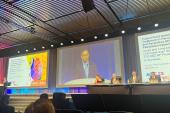Pulsed-Field Ablation Cuts AF Recurrence at 1 Year: MANIFEST-PF Registry
There was a case of phrenic nerve palsy, which raises a small red flag and will need to be watched in future studies, say experts.

BARCELONA, Spain—Real-world data on a new pulsed-field catheter ablation system for the treatment of atrial fibrillation (AF) suggest that roughly four out of every five patients will be free from AF, atrial flutter (AFL), or atrial tachycardia (AT) at 1 year.
Clinical outcomes were better in those with paroxysmal rather than persistent AF, but use of the Farapulse pulsed-field ablation system (Boston Scientific) was safe in the overall cohort, with investigators observing no esophageal damage or pulmonary vein (PV) stenosis in this large, unselected patient population.
Vivek Reddy, MD (Icahn School of Medicine at Mount Sinai, New York, NY), who presented the results of the MANIFEST-PF registry during a late-breaking clinical trial session at the European Heart Rhythm Association (EHRA) 2023 meeting last week, said there are several limitations to the new retrospective study. The frequency and/or intensity of Holter monitoring in follow-up varied across the European centers. Additionally, in terms of safety, “we don’t know what happens when more than 10,000 patients are treated,” said Reddy, noting there was one case of phrenic nerve palsy that lasted beyond hospitalization and out to 1 year.
Carlos Morillo, MD (University of Calgary/Libin Cardiovascular Institute, Canada), the scheduled discussant following Reddy’s presentation, agreed that broader safety data are still needed. The single case of phrenic nerve palsy is a “little bit of a red flag,” he said, adding that while pulsed-field ablation “might be the promised land, we may see some other complications in the future.”
Clinical trials testing various pulsed-field ablation systems for the treatment of AF are beginning to emerge. At the recent American College of Cardiology/World Congress of Cardiology 2023 meeting, researchers showed that use of the PulseSelect ablation system (Medtronic) safely and effectively reduced the recurrence of atrial arrhythmias in those with persistent and paroxysmal AF.
Pulsed-field ablation is a nonthermal ablation technique where short bursts of high-power electrical fields are applied to the targeted tissue. This destabilizes the cell membranes by creating irreversible nanoscale pores that ultimately result in cell death, while the use of nonthermal energy helps prevent damage to surrounding structures. Catheter ablation of AF is a safe procedure in the hands of experienced operators, but complications can arise, including PV stenosis, phrenic nerve palsy, and atrioesophageal fistula, with the use of thermal energy sources such as radiofrequency energy, cryotherapy, or lasers.
Right now, there are no approved pulsed-field ablation systems in the United States, but several are currently under development or are available in Europe, including Farapulse and PulseSelect.
Best Results in Paroxysmal AF
In 2022, investigators published survey results from 24 European centers participating in the MANIFEST-PF registry. Of 1,758 patients treated with pulsed-field ablation, the acute success rate was 99.9%, with zero reports of esophageal complications, PV stenosis, or phrenic nerve paralysis. However, it was a center-level analysis and no long-term efficacy data was reported, said Reddy.
The new analysis is a retrospective patient-level study of 1,568 individuals (mean age 64.5 years; 35% female) from the MANIFEST-PF registry who had persistent and paroxysmal AF treated with pulsed-field ablation after CE Mark approval of the Farapulse ablation catheter. As opposed to the prior analysis, it includes only patients undergoing a first ablation for AF. Overall, mean left ventricular EF was preserved in these patients, with a median left atrial diameter of 42 mm, and approximately 40% were taking class I/III antiarrhythmic drug therapy before ablation.
Acute success was very high at 99.2%, said Reddy. All patients underwent PV isolation, with 11% of patients also undergoing ablation in the left atrial posterior wall. A very small percentage of patients received additional ablative lines, including the roof and mitral lines, as well as ablation of the cavotricuspid isthmus. The energy used to perform these non-PV ablations was largely pulsed-field energy (85%). Procedure time was roughly 1 hour, with a total fluoroscopy time of 12 minutes.
After a median follow-up of 367 days, freedom from AF/AFL/AT was 78.1% in the entire cohort. When stratified by AF subtype, freedom from AF/AFL/AT was 81.6% in those with paroxysmal AF and 71.5% in those with persistent AF. Among patients with nonparoxysmal AF, 12-month outcomes were 71.3% for those with persistent AF and 73.5% for those with long-standing, persistent AF. Reddy cautioned, though, that relatively few patients (3%) in MANIFEST-PF had long-standing, persistent AF.
In the full cohort, 70.8% of patients were free from AF/AFL/AT, antiarrhythmic drug therapy, or redo ablation at 12 months. In the persistent and paroxysmal subgroups, those numbers were 65.1% and 73.8%, respectively. The rate of major adverse events was 1.9%, with tamponade observed in 1.1% of cases. Strokes were very rare (0.4%).
Importance of Durable PV Isolation
Reddy noted that while they did not observe any relationship between hospital volume and freedom from AF/AFL/AT, they did see better outcomes in centers that appeared to achieve more durable PV isolation. Hospitals were classified as having either a high (≥ 50%) or low (< 50%) rate of durable PV isolation based on an analysis of patients undergoing redo procedures. Centers that had a high rate of durable PV isolation had a significantly higher success rate in terms of freedom from AF/AFL/AT than centers with a low rate (81% vs 71%; P = 0.001).
“There was about a 10-point difference,” said Reddy. “This was true in the full cohort, and also true if you separate by paroxysmal and persistent [atrial fibrillation].”
Finally, Morillo said he would like to see more data on how women fared with the procedure, noting that women with persistent AF have historically not responded as well to catheter ablation.
Michael O’Riordan is the Managing Editor for TCTMD. He completed his undergraduate degrees at Queen’s University in Kingston, ON, and…
Read Full BioSources
Reddy V, on behalf of the MANIFEST-PF Cooperative. One-year outcomes from the MANIFEST-PF registry. Presented at: EHRA 2023. April 16, 2023. Barcelona, Spain.
Disclosures
- Reddy reports consulting for/receiving grant support from Abbott, Ablacon, Acutus Medical, Affera, APN Medical, Aqua Heart, Atacor, Autonomix, Axon, Backbeat, Biosense Webster, Biosig, BioTel Heart, Biotronik, Boston Scientific, Cairdac, CardiaCare, Cardiofocus, Cardionomics, CardioNXT/AFTx, Circa Scientific, CoreMap, CoRISMA, Corvia Medical, Dinova-Hangzhou Nuomao Medtech, East End Medical, EBR, EPD (Philips), EP Frontiers, EPIX, EpiEP, Eximo, Farapulse (Boston Scientific), Field Medical, Fire1, Focused Therapeutics, HRT, Impulse Dynamics, Intershunt, Javelin, Kardium, Keystone Heart, LuxMed, Manual Surgical Sciences, Medlumics, Medtronic, Middlepeak, Neutrace, Newpace, Novartis, Novo Nordisk, Nuvera (Biosense Webster), Nyra Medical, Oracle Health, Philips, Pulse Biosciences, Restore Medical, Sirona Medical, SoundCath, Surecor, Thermedical, Valcare, and Vizaramed.





Comments